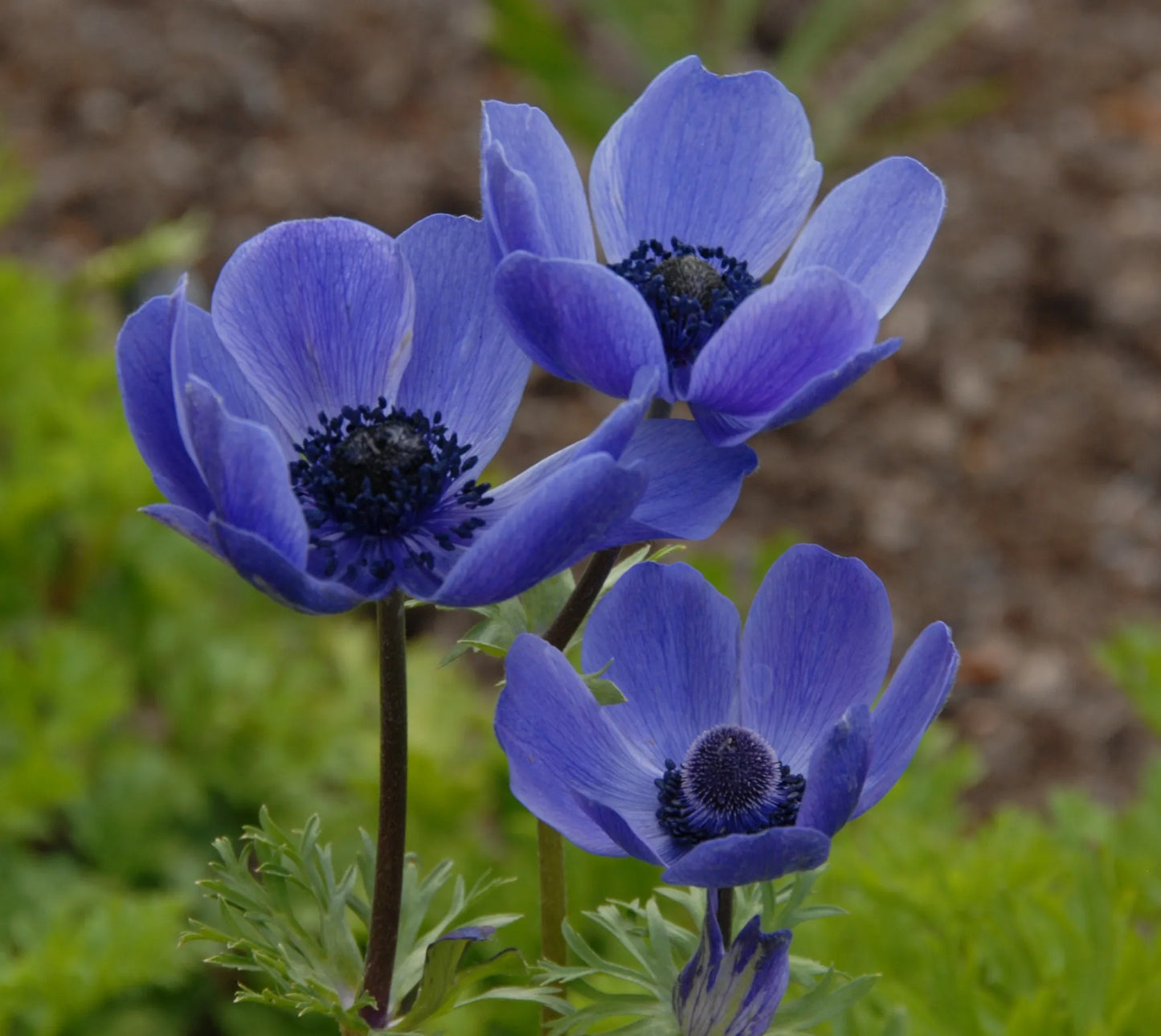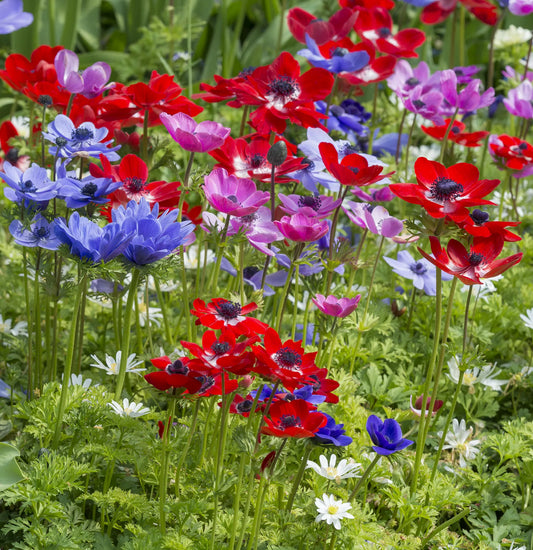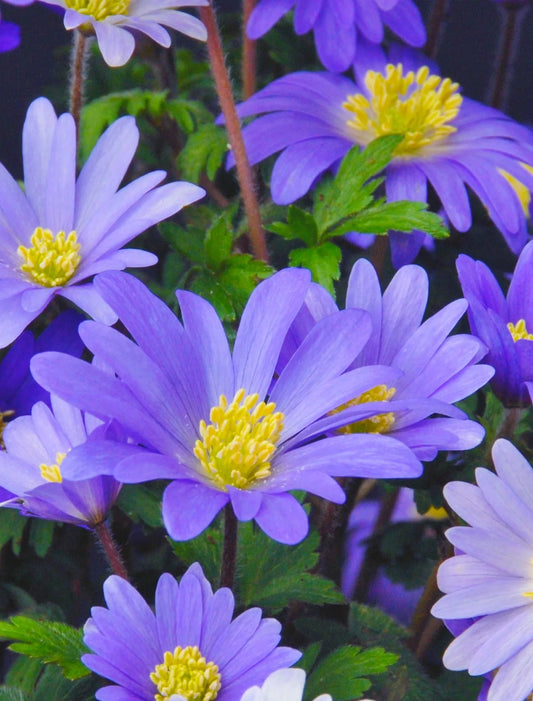-
Livraison dès 10 bulbes France, Suisse et Europe
Modalité livraison -
Grossiste Bulbes de fleurs en ligne
-
Bulbes de Qualité
-
Paiement sécurisé
Virement / chèques / Carte Bancaire /Chorus
Untreated Anemone Mr. Fokker flower bulbs size 7/8 (5000800)
Untreated Anemone Mr. Fokker flower bulbs size 7/8 (5000800)
PRICE per bulb € excluding VAT excluding transport
Delivery from mid-September to November - choice at the basket stage
Online shopping available in France and Belgium. For other countries, please request a quotation.
Couldn't load pickup availability
 Limited stock - Buy now and get it delivered when you're ready to plant
Limited stock - Buy now and get it delivered when you're ready to plant
- Delivery from 10 bulbs to France, Switzerland and Europe
Flower Color:
Usage:
Flowering:
View full details

Quality Anemone Bulbs for Floriculturists and Individuals
Quick read / the essentials about our Anemone Bulbs
At Floriverse , we support French florists with recognized expertise as a specialist wholesale supplier of flower plants . Our complete range of Anemone bulbs is designed to meet the requirements of professionals in terms of yield, floral quality and logistical reliability. Each batch that you can buy Anemone bulbs from us is rigorously controlled and calibrated to ensure uniform, abundant flowering adapted to the commercial requirements of the cut flower market.
We offer highly productive conventional bulbs, but also a complete range of untreated and certified organic bulbs, for farms focused on sustainable agriculture. As a specialist wholesale supplier of flower plants , we provide you with precise know-how, tailor-made technical support and controlled logistics. Whether you are in the PACA region, Pays de la Loire or elsewhere, you can buy Anemone bulbs and benefit from a professional cultivation itinerary, technical monitoring and unrivaled value for money.
With Floriverse , you have access to a selection of bulbs from the best varietal strains, capable of producing long, rigid stems and flowers with vibrant colors. Thanks to our status as a specialist wholesale supplier of flower plants , you gain in responsiveness, security of supply and reliability, whatever the size of your structure. To make your floral campaigns a success, don't hesitate to buy Anemone bulbs from a partner who understands the realities on the ground.
Introducing our Anemone range
At Floriverse , we offer floriculture professionals a wide range of Anemone flower bulbs , rigorously selected to meet the technical and economic requirements of French producers. Our offer includes conventional bulbs, untreated bulbs, as well as a wide range of organic Anemone flower bulbs , adapted to the specific needs of AB certified productions. Each bulb benefits from a certified origin, thus ensuring quality, homogeneity and reliability for early, abundant and commercially optimal flowering.
Market approach: Anemone cultivation in France
Analysis of the Anemone Cut Flower Market in France (2022-2025)
Before presenting the details of this analysis, here is a summary of the main findings: the anemone is positioned as the second most produced cut flower species in France with 16.8 million stems annually, representing 9% of national production. The market is experiencing positive post-Covid dynamics, despite significant structural challenges in the French cut flower sector.
State of the Cut Flower Market in France
Recent production data and trends
- The anemone is the second most produced cut flower species in France (16.8 million stems/year), just after the peony (18.8 million).
- It represents 9% of the total volume of national production of cut flowers.
- The vase life of Var anemones is approximately 11 days, ensuring excellent commercial longevity.
- Between 2019 and 2021: 17.9% increase in sales value despite a 19% decrease in the number of specialized farms.
- In 2022: overall decline in purchases of cut flowers of 7% in volume and 9% in value compared to 2021.
Geographical distribution of production
- The PACA region represents 42% of national production, notably thanks to the Var.
- The Pays de la Loire region follows with 41% of the national volume produced.
- The other regions (Nouvelle-Aquitaine and Île-de-France) remain marginal, accumulating only 6% of the national turnover linked to cut flowers.
Specificities of Anemone Production
Technical characteristics of the culture
- Grown from tubers (“legs”) requiring 48 hours of rehydration before planting.
- Planting possible from March to May for summer flowering (June to August).
- Growing from legs guarantees precocity, abundance and quality.
- The above-ground production tested at SCRADH significantly improves working conditions and profitability.
Post-Covid market dynamics
- Growing attractiveness of the sector, encouraging professional retraining towards floriculture.
- Emergence of diversified and sustainability-focused “flower farms”.
- Increased interest in local flowers.
- Wealthy households (incomes above €3,000) represent 43.5% of buyers in 2022 compared to 41.9% in 2021.
Organic vs. Conventional Production
- Unstructured organic production with limited data.
- Development of new farms often geared towards sustainable development without necessarily being AB certified.
- Major challenges in conventional farming linked to phytosanitary restrictions, leading to strong regulatory pressure on producers.
- “Flowers of France” label widely used as a distinctive sign.
Outlook for Anemone Bulb Suppliers
- Growing opportunity linked to new post-Covid operations.
- Significant potential in the PACA and Pays de la Loire regions (83% of national production).
- Need for innovative technical solutions to overcome regulatory restrictions.
- Potential for development in sustainable agriculture, even if the organic market remains limited.
Presentation of our commercial arguments
As a flower bulb specialist and floriculture specialist , Floriverse guarantees you a simple and seamless agricultural supply, without complications. [...]
Technical presentation of the genus Anemone for professional floriculturists
Anemones , also known by the evocative name of " windflowers" , represent a plant group of great interest for professional horticulture and floriculture . Intended for the production of high-quality cut flowers , integration into sustainable landscaping or the enhancement of collective spaces, these plants offer a range of varied technical and ornamental characteristics .
Botanical classification and geographical origin
The genus Anemone L. , established by Carl von Linné in 1753, is part of the family Ranunculaceae (Buttercups). This genus includes a diversity of species, estimated at about 120 to 200 , whose classification has undergone several revisions over time, dividing it into subgenera and sections . The taxonomic position according to the APG III phylogenetic classification places the genus Anemone in the order Ranunculales. It should be noted that genera such as Hepatica and Pulsatilla have sometimes been included in a broad sense of the genus Anemone .
Geographically, species of the genus Anemone are widely distributed throughout temperate and subtropical regions of the globe, with the notable exception of Australia and New Zealand. Their natural habitat varies considerably depending on the species. For example, Anemone sylvestris is a Euro-Siberian species found from northern France to central Asia. Land anemones generally prefer humus-rich, light, and well-drained soils , with exposure ranging from full sun to partial shade depending on the variety and climate. Some species are found in moist, cool undergrowth ( Anemone nemorosa ), others at the base of trees or shrubs ( Anemone blanda ), and some are adapted to rockeries on calcareous or dry soils ( Pulsatilla vulgaris ).
Morphological description and vegetative cycles
The underground storage organ commonly called a "bulb" in the anemone is actually a corm . This corm, with a solid interior, appears as a small, dry, hard, irregular mass (rounded or triangular). Its outer surface is dry, scaly, sometimes wrinkled or warty, with a color varying from brown to dark brown, sometimes slightly gray. For professional cultivation , the size of the corms is crucial and measured in centimeters. Common sizes for Anemone coronaria vary from 2/3 cm to 4/5 cm in diameter. Large sizes (4/4, 4/5 cm and beyond, such as 5+, 6/7, 7/8 cm) are preferred because they guarantee better vigor and more abundant flowering .
Anemone foliage is typically basal and divided into leaflets. For most cultivated varieties, the foliage is deciduous . Mature plant height varies greatly depending on the species, ranging from about 15 cm for low-growing species such as Anemone blanda to 1.5 m for taller varieties of Japanese anemone ( Anemone japonica/hupehensis ). The spread can vary from 15 cm to 90 cm depending on the variety. The general habit is upright to slightly spreading, forming upright or dense, elegant clumps .
The vegetative cycle of spring anemones includes a summer rest period , adapted to the dry conditions of their native regions. The species are divided into two main groups : those with spring flowering (generally smaller) and those with autumn flowering (taller).
Anemone flowers are characterized by a cup-shaped corolla and a distinct heart . They are usually composed of 5 to 8 petaloid sepals and can be single or double in structure. The petals are often described as delicate and fine . The color palette is extensive, including white, pink, blue, red, violet, dark purple, salmon pink, and various wine or mottled shades, especially in Italian varieties such as the Mistral/Levante series. Flower size and stem length vary among cultivars; for example, Var anemones can reach 45 cm in height with straight, stiff stems , particularly suitable for cut flowers . As a general rule, cut anemones are considered scentless . The flowering period generally extends from March to October depending on the species and cultivation methods.
Life cycle, longevity and multiplication
The majority of anemones grown professionally are perennials . This means they are able to live for several years and re-flower each season from their underground organs (corms, rhizomes or tubers). These organs allow the plant to survive adverse seasons , whether dry summers or cold winters. The longevity of established perennial anemones varies, generally being between 3 and 10 years under good growing conditions. Some very robust clumps, such as those of Anemone hupehensis , can persist and flower for 15 years , or even more than 20 years if conditions are optimal, including well-drained soils and the absence of disease. For intensive cut flower production , especially Anemone coronaria in a greenhouse, the cycle is often managed as an annual to maximize yield, although the plant is naturally a perennial.
The preferred method of propagation in professional anemone cultivation is by corms . This method is the most reliable for obtaining genetic homogeneity , essential for standardizing batches and varietal fidelity . Rehydrated corms emerge quickly, offering flowering as early as 3 months after planting in a greenhouse. Propagation by rhizome division is applicable to perennial species such as Anemone nemorosa or Anemone hupehensis , allowing recovery and growth in a few weeks. Propagation by seed is little used by professionals for Anemone coronaria due to its slowness, a variable success rate and the heterogeneity of the plants obtained.
Cultural requirements and optimal conditions
An optimal soil for anemones should be light, deep, rich in organic matter and imperatively well-drained to prevent rotting of the roots , which are particularly sensitive to water asphyxiation. The addition of compost , decomposed manure or coarse sand in heavy soils is recommended. The ideal pH is between 6.0 and 6.8 (slightly acidic), although some sources indicate a tolerance of between 5.5 and 7.5 . Soil preparation involves fine cultivation to a depth of 20 to 30 cm .
Regarding exposure , anemones require bright light . In most regions of France, full sun (6 to 8 hours of direct sunlight per day) is optimal for flowering. In Mediterranean regions or during hot periods, partial shade (4 to 6 hours of direct sunlight) is preferable to protect the bulbs from excessive heat. Dense, permanent shade should be avoided as it reduces vigor and flowering .
The planting schedule depends on the species and the climate. Autumn planting (September to October) is generally recommended for spring-bearing species to allow rooting before winter . In cold climates, spring planting is a viable alternative. Rehydrating the corms by soaking (6 to 24 hours) is a key technical step before planting. Bulbs are generally planted between 5 and 10 cm deep , commonly 8 cm , with the tip pointing upwards. Spacing varies from 5 to 15 cm depending on the desired effect; a spacing of 5 cm creates a mass effect , while 10 to 15 cm allows for better individual development . For professional cultivation in the open ground, a spacing of 5 to 10 cm is common.
Water requirements for terrestrial anemones are moderate . The soil should be kept moist but never soggy . Regular watering is important during the active growth phase, but watering should be reduced during summer dormancy when the plants tolerate, or even appreciate, dry soils . Localized irrigation such as drip irrigation is recommended to manage water supply, especially during prolonged drought.
In terms of fertilization , anemones benefit from soil rich in organic matter . A balanced fertilizer (NPK 10-10-10) is recommended. Light fertilization at the beginning of growth or as a maintenance every 3 to 4 weeks with a bulb fertilizer during the active period can be beneficial. Excessive nitrogen late before winter should be avoided.
Anemones are hardy to about -4°C (USDA Zone 7). Lower temperatures can damage the corms , causing frost and potential rot. In areas with severe winters (USDA Zone 6b and below), protection is necessary (low tunnel, winter fleece, or greenhouse cultivation). Mulching (10-15 cm in winter) is an effective method to protect the bulbs from deep frost . Anemone coronaria requires temperatures above 0°C in winter .
Culture management and maintenance
Routine maintenance of a professional anemone crop involves meticulous weeding , particularly during the establishment and growth phase. Weeding every 2 to 3 weeks is recommended, supplemented by mulching to limit weed growth . Regular removal of faded flowers is crucial to stimulate the production of new flower stems and extend the flowering period . This operation is ideally carried out at least once a week or at each harvest. Staking is generally not necessary for professional varieties with stiff stems , but may be considered in the case of very dense crops or windy conditions .
Mulching , in addition to its role in weed control, is useful for retaining soil moisture in summer and essential for winter protection , especially during the first winter after planting or in cold regions . An organic mulch such as dead leaves or straw is suitable for open ground, while a mineral mulch (gravel) is recommended for potted crops to limit surface moisture.
Crop rotation is strongly recommended for anemones to avoid monoculture , which promotes the accumulation of soil pathogens and specific depletion . A rotation duration of at least 3 to 4 years is advised before replanting anemones on the same plot. Rotations with unrelated flower crops such as Lisianthus , Limonium , Peony or Hydrangea are common and beneficial. Rotations with species sharing the same disease susceptibilities , such as Chrysanthemum , are best avoided.
Main cultivars and selection
Anemone coronaria L. is the most recognized species in the French horticultural sector, particularly for cut flowers . Selection efforts have given rise to distinct commercial series such as Spring Beauty and Summer (AB Cultivars) for staggered flowering . Varieties in the Mistral and Levante series, notably Levante Wine with its double flowers and intense colors , are very popular. Var anemones are particularly renowned for their large stems (up to 45 cm), straight , rigid and robust . Varietal improvement has led to the development of tetranemones , characterized by a later entry into production but thicker and longer stems , and larger diameter flowers . The Mona Lisa and Marianne varieties are the result of this work. The French sector , particularly in the Var, has implemented precise standardization (length, sorting, flowering stage) and specific packaging to promote production on the professional market.
Relevance for specific uses
For cut flowers , the anemone is very suitable. Its advantages include the length of the stems (up to 45 cm ), their rigidity which allows them to hold well , excellent vase life (about 7 to 10 days if harvested at the right stage), and a wide variety of shapes and colors . Its limitations are the tendency of the stems to bend in the light , the relative fragility of the petals , and the absence of any notable fragrance .
Anemones are ideal for landscaping . Taller types such as Anemone coronaria are ideal for beds , creating bright splashes of color . Shorter species such as Anemone blanda (about 15 cm) are excellent for borders and rockeries . Many species, such as Anemone nemorosa , Anemone blanda , and Anemone coronaria , have excellent naturalizing abilities , spreading by seed or rhizome extension and quickly forming dense mats . The recommended planting density varies from 25 to 75 bulbs/m² depending on the species and the desired effect.
The anemone is particularly relevant for communities and managers of large public spaces thanks to its great ease of maintenance once established ( low watering and fertilization requirements ), its resistance to diseases and pests , its abundant and long-lasting flowering (from March to October depending on the species), and its capacity for naturalization . Its versatility of use ( flower beds , borders , rockeries , undergrowth ) is also a major asset.
Anemone coronaria is ideal for forcing in a greenhouse or indoors to achieve off-season flowering (winter/early spring). This technique involves rehydrating the corms , planting them in a sheltered area ( density of 200 to 400 tubers/m² ), maintaining controlled temperatures (12-18°C) and, if necessary, providing light to achieve a photoperiod of 12 to 14 hours . Forcing helps to anticipate flowering (2 to 3 months after planting) and improve flower quality . Growing in pots or under cover requires a well-draining substrate (potting soil, compost, sand/perlite) and careful watering management to prevent rot.
Plant health and risk management
Although cultivated anemones have some resistance , they can be subject to problems , particularly fungal and bacterial , often linked to excess humidity , high temperatures or poor quality of the environment . In intensive professional cultivation or in confined environments, these diseases can affect a significant proportion of batches. Parasites such as larvae , worms or protozoa are also possible.
Visual indicators of good health include bright green, well-developed foliage , compact rosettes , abundant blooms with flowers that open fully during the day, and good vase life (about 11 days for a healthy cut flower). Signs of stress or deficiency are shown by yellowing foliage , slowed development , reduced blooms , or poor flower quality . Moisture management , proper soil pH (5.5-7.5), sufficient light exposure , and good ventilation are essential to maintain plant health .
Disease and pest prevention is based primarily on controlling environmental conditions : maintaining good soil and water quality , avoiding overcrowding , regularly inspecting plants , and quarantining new arrivals. If problems occur, adjustments to cultivation parameters or, in severe cases, specific treatments under professional supervision may be considered.
Harvesting and storing corms
Corms are harvested when the foliage has completely dried , marking the entry into dormancy (late spring/early summer). The corms are gently extracted , then dried in the shade in a ventilated place for several days to eliminate residual moisture . Clean corms are stored in a dry, dark, well-ventilated room , at a stable temperature between 10 and 15°C and low humidity (around 60%). They must be stored in containers that allow ventilation (crates, paper bags) and not in plastic . Regular monitoring is necessary to remove corms showing signs of rot . To maintain vigor and optimal yield , it is recommended to replant the corms every year .
Influence of corm size and renewal
Corm size has a direct and significant influence on vigor and flowering . Large corms (5/6, 6/7 cm and more) contain more energy reserves , which results in a stronger plant , earlier flowering and a higher number of flowers (for example, 15 to 18 flowering stems per plant in the first year for large corms, compared to 7 to 10 for smaller ones).
For professional production , choosing large calibers is essential to guarantee high-yield production and consistent quality .
Dividing the clumps , recommended every 3 to 5 years after flowering (spring or autumn), helps maintain the vitality of established plants , avoid soil depletion and regenerate the stock .
To summarize: Our Anemone Bulbs
The anemone is one of the essential species for cut flowers in France, with a dynamic national production centered in the PACA and Pays de la Loire regions. Thanks to its spread flowering, excellent vase life and remarkable diversity of colors, it appeals to plant professionals. To meet this growing demand, Floriverse offers you an exclusive selection of calibrated corms, ready to integrate into your growing calendars. As a wholesale supplier specializing in flower plants , we guarantee regular availability, controlled stocks and fast deliveries throughout the country.
Whether you're just starting out or diversifying, you can buy Anemone bulbs from Floriverse and benefit from personalized technical support, including cultivation itineraries, varietal advice, and post-planting support. Our professional corms are suitable for both outdoor cultivation and greenhouse production, including forcing strategies. Our customers also appreciate our flexible ordering model: buying Anemone bulbs online or by quote, with sliding scale pricing, allows you to manage your budget with complete peace of mind.
Trusting Floriverse means relying on a specialist wholesale supplier of flower plants committed to the success of the French floriculture industry. Our offer includes both conventional bulbs and untreated or organic references, always delivered with care and traceability. With Floriverse, you choose performance, reliability and support. For your next campaigns, don't wait any longer to buy Anemone bulbs from an expert partner in the professional horticultural market.
-
Untreated flower bulbs Anemone De Caen size 7/8 (5000400)
Regular price €0,13 EURRegular priceUnit price / per -
Untreated Anemone Bride Flower Bulbs 7/8 Size (5000600)
Regular price €0,13 EURRegular priceUnit price / per -
Untreated Anemone blanda (Blue Shades) flower bulbs size 5/6 (5000100)
Regular price €0,07 EURRegular priceUnit price / per -
Untreated flower bulbs Anemone Sylphide size 7/8 (5000900)
Regular price €0,13 EURRegular priceUnit price / per -
Untreated Anemone St. Brigid Flower Bulbs Size 7/8 (5001000)
Regular price €0,14 EURRegular priceUnit price / per
Floriverse: Online wholesaler of flower bulbs
-
-
Wholesale Flower Bulbs Online
We work with dozens of producers to offer you the best prices for your flower bulbs.
-
Quality
Our producers are selected for their reliability and the quality of their bulbs.
-
Your bulbs at the best prices
We work every year with your partner producers to offer you the best prices







